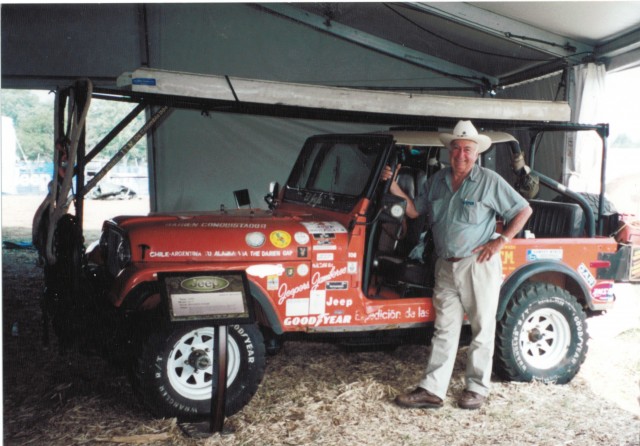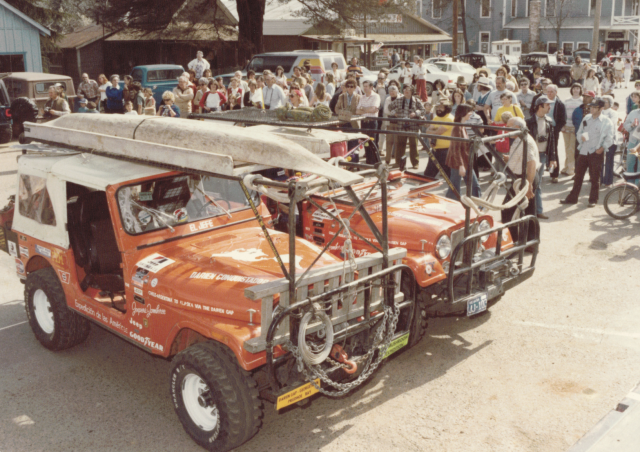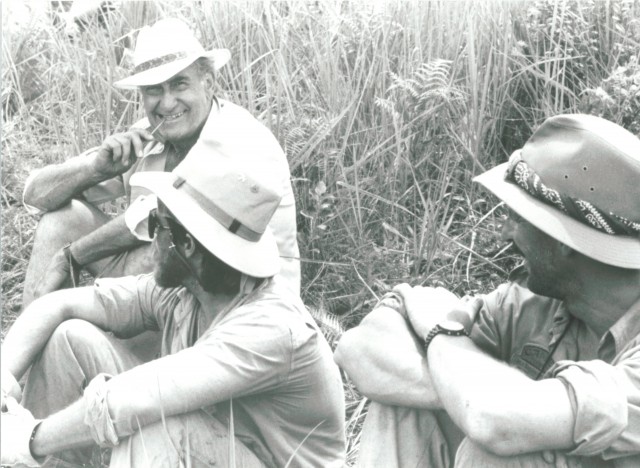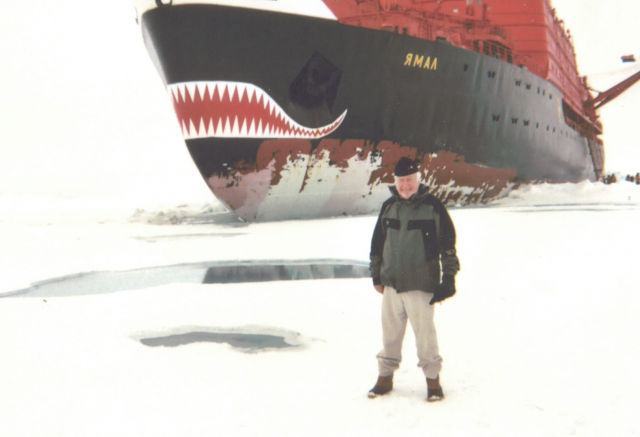This morning we lost one of the world’s most adventurous spirits, Mark A. Smith. I had the honor of knowing Mark, had worked and travelled with him, and considered him a friend. He was an inspiration to millions, mentor to many. A few years ago I spent a couple afternoons with Mark. We had lunch and chatted about life, adventure, and Jeeping; he loved each with passion and conviction. A few months later Mark was featured in Overland Journal’s Living Legends; which he truly was. I wanted to share this.
Chris Collard
Editor-in-Chief, Overland Journal
The interview below first appeared in the Winter 2012 issue of Overland Journal.
I first met Mark Smith in 1995. I’d walked into the offices of Jeep Jamboree USA (JJUSA), in Georgetown, California, with a large package under my arm. I was their new UPS guy. Mark pulled into the parking lot, energetically climbed out of his Jeep Grand Cherokee, made a beeline for the building, and swung open the rustic office door… “Good morning, everyone.”
From my rookie-adventurer standpoint, Mark was a legend in the four-wheel drive world. He was one of the founding fathers of the famed Jeepers Jamboree, on the Rubicon Trail, and had led the first unsupported expedition through the Darien Gap—Colombia to Panama in 1979—Part of Expedition de las Americas, a six-month trek from Ushuaia, Argentina to Prudhoe Bay, Alaska. Mark is the type of man whose reputation and persona precede him. A square shooter, who will look you straight in the eye if he has something to say. Though he’s not from the South he speaks with bit of a Southern drawl and with a tightened gait to his jaw, reminiscent of a young Clint Eastwood. Having served as a U.S. Marine during WWII, he’s probably fairly handy with a sidearm as well. Not wanting to appear like a star-struck wannabe, I looked up, said good morning, and kept to my work.
A few years later I was on a flight to North Carolina. I’d somehow fandangled my way into working for JJUSA as a trip guide on some of their U.S. events. Mark, sitting to my right, had negotiated my upgrade to First Class and was proceeding to share his personal recollections of the Darien. On layover at the Denver airport, I could barely keep up with him as he marched through the terminal, long grey ponytail trailing from under his Jeep ball cap, towards the United Red Carpet Club. Even the casual observer could see his life was one of purpose and direction; each move calculated, each turn with a goal in mind.
It’s been years since I delivered my last package to the Jamboree office. But recently, after attending the 60th annual Jeepers Jamboree, I had a chance to have lunch with Mark. At 85 years of age, his youthful eyes have an unmistakable twinkle to them; his smile and enthusiasm are contagious. In the past six decades, his adventurous spirit has led him through more than 100 countries, across six continents, and to the North Pole. He has worked with Camel Trophy, been an advisor for auto manufacturers, and juggled a dozen careers: some sequentially, some simultaneously.
It is said that people view life with the glass half full or half empty: I doubt Mark’s cup is ever a sip below full. At lunch he said to me, “If you have a dream, you need to follow it, no matter what.” It’s been a pleasure to know Mark personally, and I’m honored to introduce you to one of the World’s true living legends: Mark A. Smith, the Father of Jeeping.
You grew up in the remote mining town of Kimberly, Nevada, in a family with a long lineage of miners. How did you occupy your time as a youth, and when did you realize that exploration would become part of your life?
As a little boy, I’d get up in the mornings and go out exploring. I had a dog named “Jeep,” after Eugene the Jeep in Popeye cartoons. We would walk around and catch lizards, horned toads, and chipmunks, and just enjoy the outdoors. I could never understand why in the mornings, when the sun was coming up, other people wanted to sleep in. I would look out and see so much to do. I couldn’t wait to get up and go exploring.
That was years before World War II and the creation of the Willys Jeep. Considering you’re your life has revolved around Jeeps, naming your dog “Jeep” was rather prophetic. Do you believe in fate or destiny? Was there something you knew at the time?
In some ways, I think people make their own destiny. You need to pursue your dreams and not give up. Destiny has something to do with what we end up doing, but it also takes determination and perseverance to make your dreams come true. You just can’t sit back and think that they will come to you.
You joined the Marine Crops in ‘44, and at the end of the war you were assigned to the USS Little Rock for a round-the-world “Goodwill Tour.” Was this your first exposure to the rest of the world? How did it affect your future ambitions to travel?
I got very lucky. I’d put in for Sea School training and was approved. We were heading for the Panama Canal and the South Pacific for the invasion of Japan, when we got word that the Japanese had surrendered. We were reassigned to a nine-month Goodwill Tour, beginning in every major port in South America, then Africa and Europe. Unfortunately, my platoon ended up in the Okinawa invasion and some of them didn’t make it back. I’ve always felt regret that I did not go into combat with the platoon I had trained with. Yet, I realize now I was very fortunate for what the future had in store for me.
I have always been interested in ancient history and of course, travel. My mother was a history bluff. She started my interest at an early age. Studying ancient history in school also added to my curiosity. The Goodwill Tour added to my interest in travel. Visiting these ports and learning the history, as well as what the area was known for, was my number one priority.
After the war you moved to Georgetown, California and bought a surplus military Jeep for $500. A few years later you were involved with the first Jeepers Jamboree. Can you tell us about it?
In 1952, a small group of Rotarians met at my house to discuss the possibility of a Jeep trip across the Sierras on the Old Rubicon Trail. The purpose was to help the depressed economy of the Georgetown Divide area. Several pre-scouting trips were made to determine the route and camp areas. The first Jamboree was held in August of 1953. We had 55 Jeeps and 155 people. It was a big success and continued to grow over the years. It was a huge help to the town’s economy. The Georgetown Rotary Club and the Georgetown Rifle and Gun Club became the first sponsors, and I was named “Jeepmaster,” a title that lasted for 40 years.
How did your involvement with Jeepers Jamboree lead to a relationship with AMC/Jeep?
The second year of the Jamboree, people from Willys Motors Company, including a few top executives, started coming with us. [Mark laughs] We were actually showing them what their vehicles were capable of. The relationship grew from there and survived the changes to Kaiser Motors, American Motors, Chrysler, Daimler, and Fiat. I worked with Jeep on the introduction of the CJ-7, Cherokee, Wrangler, and Comanche, and built more than 100 driving courses around the country, including a mini Rubicon at their proving grounds in Chelsea, Michigan. I continued to work as a consultant for many years.
You made several trips to the Baja peninsula in the 1950s, before the paved road was built. What drew you to Mexico and this remote region? How far south did you venture and how long did it take?
It was just another place to explore and learn about. I went all the way to the tip at that time; it took seven days from the border to La Paz. It was a very primitive dirt road.
In 1978, you and a group of fellow Jeepers embarked on a six-month trek through North and South America. This included crossing the Darien Gap between Panama and Columbia. How and when did you come up with the concept for this expedition?
It started as a twelve-year dream and a challenge. After doing the Rubicon for so many years, I started looking for the ultimate challenge with a Jeep, just as a mountain climber looks for a higher mountain. The Darien was it.
I first heard about the Darien when I was in my 30s. It was the uncompleted portion of the Pan American Highway. There was 250 miles of primitive jungle and swamp, with up to 400 inches of rain each year. I read an article about a couple of guys trying to cross the Darien in a Land Rover who had been unsuccessful. I started thinking about doing Darien in the 1960s. I would describe the Darien as 10 times tougher and 10 times harder than the Rubicon.
How did you gather information for an endeavor of this scale? Were exploratory scouting trips necessary?
The Darien was part of a six-month expedition from Ushuaia, Argentina, to Prudhoe Bay, Alaska. It was a snake- and insect-infested 250-mile stretch of jungle and swamp between Columbia and Panama. We made two scouting trips to Panama and Columbia [1976 and 1977] to get an idea of what we were getting into and what type of equipment we would need.
A major British Army unit was the first to cross the Darien. There were 250 men involved, including British Army engineers, Colombian Navy, and Panamanian Guardia. It took them 100 days to take two vehicles through. They lost eight Columbian Marines in a river crossing.
During our first scouting trip, we returned to the hotel after several days in the jungle—we were exhausted. We took a straw poll, voting one-to-ten on what our chances would be of completing the Darien. Four of us came up with 90 percent odds against us; the jungle was just too fierce. That night in the hotel I lay in bed awake. I knew there must be an answer.
On the second trip we flew over the Atrato Swamp in Columbia. It is a vast and green swamp with water channels 50 feet wide. Our Colombian friend Carlos Martinez had obtained high-altitude reconnaissance photos, showing the areas we would have to cross. After pre-scouting, we took another vote on our chances of completing the crossing. This time we felt we had a 90 percent chance of success .
How did you select your team and can you tell us about the equipment needed?
We worked with AMC Jeep, who provided us with five stock CJ7s. Bill Ramsey at Ramsey Winch provided winches for the Jeeps, and we had two PTO winches.
One of the things we learned from the British was about the use of bridging ladders. Theirs were long and heavy, so we set out to design ladders for our specific needs. We recruited an engineering student named Jeff Halston to build the ladders, which were made of aluminum. He also built pontoons for floating the Jeeps across the Darien’s many rivers. We could never have succeeded without the bridging ladders, but we never ended up using the pontoons. Instead we recruited the Indians and their canoes to float the Jeeps. One river crossing was on a balsa wood raft built by the natives.
As for the crew, we had 14 handpicked Americans, 3 Colombians, and 25 Chaco Indians, who cut trail for us. Because the Indian bush cutters from Colombia did not have Panama visas, they turned back mid-way, and we recruited Indians from local villages. We entered the jungle on January 15, 1979. With the team effort and equipment we had, we made it through the 103 miles in 30 days.
Would you say there was a secret to your success in the Darien?
One of the things the Marine Corps taught me was to never give up. We were also taught to stand our ground and never retreat. And, that if you were in command, never ask anyone to do something that you wouldn’t do.
I heard rumors that during the Mexico segment of Expedition de las Americas, you drove straight through a military checkpoint in Mexico without stopping. What happened?
At that time, the official vehicles in Latin American countries were orange. Our Jeeps were orange and looked official. Approaching the military checkpoint, using CB radio, I told the guys we would bluff to see if we could get by. As I approached the checkpoint, I saluted and kept driving. They looked dumbfounded; we continued with no problem.
Can you tell us about working with the Camel Trophy?
I was retained by Duncan Lee of Reynolds Tobacco to lead the 1987 Camel Trophy in Madagascar. It required three trips to England for meetings, training, and final selection of teams. It also required a two-month scouting trip. For this we had a Land Rover, two Range Rovers, and eight people.
At the time, I had no problem with working with a non-Jeep vehicle. The scouting was over very primitive terrain and washed out bridges; it was an expedition in itself. The actual event was a series of forced deliberate hardships. Teams competed against one another through obstacles, compass routes, and winching, and were rated on different segments. All teams needed to carry their own supplies: food, spare parts, anything that might be needed to complete the event. At one point, the vehicle I was in crossed a swampy area. Water was up over the headlights and up to my waist. The vehicle was still running because of the snorkel and being a diesel. I kept looking down to see if there was anything swimming with me in the vehicle.
You started Jeep Jamboree USA in 1983 and began leading Jeep trips all over the U.S. In what other countries have you lead Jamborees?
We’ve held Jamborees in Australia, Europe, Canada, and Mexico.
Many people might think you’ve spent your life driving Jeeps around the world, but you’ve also had careers as a miner, airport manager, sheriff’s deputy, owner of a lumber company, and real estate developer and broker. How have you juggled so many careers and still managed to travel?
Where there is a will, there is a way. I have always been capable of doing several things at a time. Many of the trips and travels just blended together. I have always lived for a challenge.
At the first Jeepers Jamboree you were deemed “Jeepmaster,” and for years you have been referred to as “The Father of Jeeping.” Has carrying this title levied additional responsibilities?
I wouldn’t say it levied additional responsibilities. It has made me aware and determined to fight those that are constantly trying to close public lands. I have made the commitment to do what I can to keep trails open. I learned a long time ago to not be afraid to challenge authority. Those in a position of power are not always right.
You have traveled through most of the world, much of it by four-wheel drive. Do you have a favorite place, one that you would like to return to, or suggest others to visit?
Australia has drawn me back about 20-25 times. I have probably seen more of Australia than many Australians. We did many events in Australia, including the reintroduction of Jeep. I still have the interest and drive to explore. A few years back, I went to Myanmar, formerly known as Burma. We went with the intent of retracing the old Burma Road of WWII fame. The road was used to transport war materials from India to China to assist the Chinese in fighting the Japanese.
Have you kept track of the number of countries and continents you’ve visited?
It would be easier to say which continents I haven’t visited, which would be Antarctica. With my own travels and with the Marine Corps, there aren’t many countries I haven’t visited.
I’ve heard rumors about a special tattoo?
Yes, I have a “Jeep” tattoo. It’s on my butt.
You have been married to your wife, Irene, since 1951. During this time you have been gone on expeditions for up to six months at a time. What is your secret to extended travel and a happy marriage?
Probably what contributed to a long lasting marriage with Irene was being gone so much. Both of us have a sense of humor. I think you need one to put up with some of the things I have done
At 85 years of age, you still come into the office every morning at eight o’clock . Are you planning on retiring?
Many people have asked, “When are you going to retire?” My answer is “When I die.” Why, I’m having too much fun, loving life, and experiencing new adventures. When I’m gone, if there is another world out there, I’ll probably be exploring it with my dog in my Jeep.
Do you have any regrets, things you might have done differently?
No
Lastly Mark, do you have any advice for us? For someone who dreams of creating an exceptional overland trek, or a life of expedition travel?
Many people have said that I have more guts than brains. If you have the dream or desire to do something, do it. Also, enjoy old age, don’t complain, not everyone has that privilege.
Below is the last known interview with the legend himself.



















